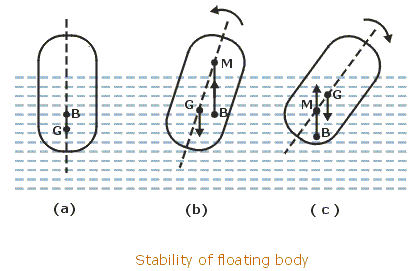
Web Project by Ben Renshaw, PHYS-104
Home
The Sail Boat
- Buoyancy
- Center of Gravity
- Sailing
- Navigation
- Anchors
Bibliography

http://www.tutorvista.com/content/physics/physics-iii/solids-and-fluids/floating-and-sinking.php
We have all been in a boat when someone starts to rock back and forth. Intuitively, we know that if the boat tips far enough it will flip. What exactly causes the boat to flip?
For a floating object to be stable the center of gravity (G) must be below the center of buoyancy (B), as in case "a". The metacenter (m) is a line that intersects both the center of gravity and the center of mass. The center of gravity is pushing the boat downward while the center of buoyancy is pushing the boat upward. When a boat is being rocked back and forth (G) and (B) are coming closer together thus decreasing the metacenter; when (B) gets lower than (G) the boat is going to flip as in case "c".

http://sharkbait.shark.nu/2010/07/28/my-ideas-to-solve-the-neck-weight-problem/
Sailboats would flip a lot more often of it were not for their keel. The keel is a very heavy fin at the bottom of the sail boat, that effectively lowers the center of gravity, increasing the distance from the buoyant force.
http://www.sail-race.com/classes/index.htm
The crew often
use their own body weight in order to stabilize the
boat.